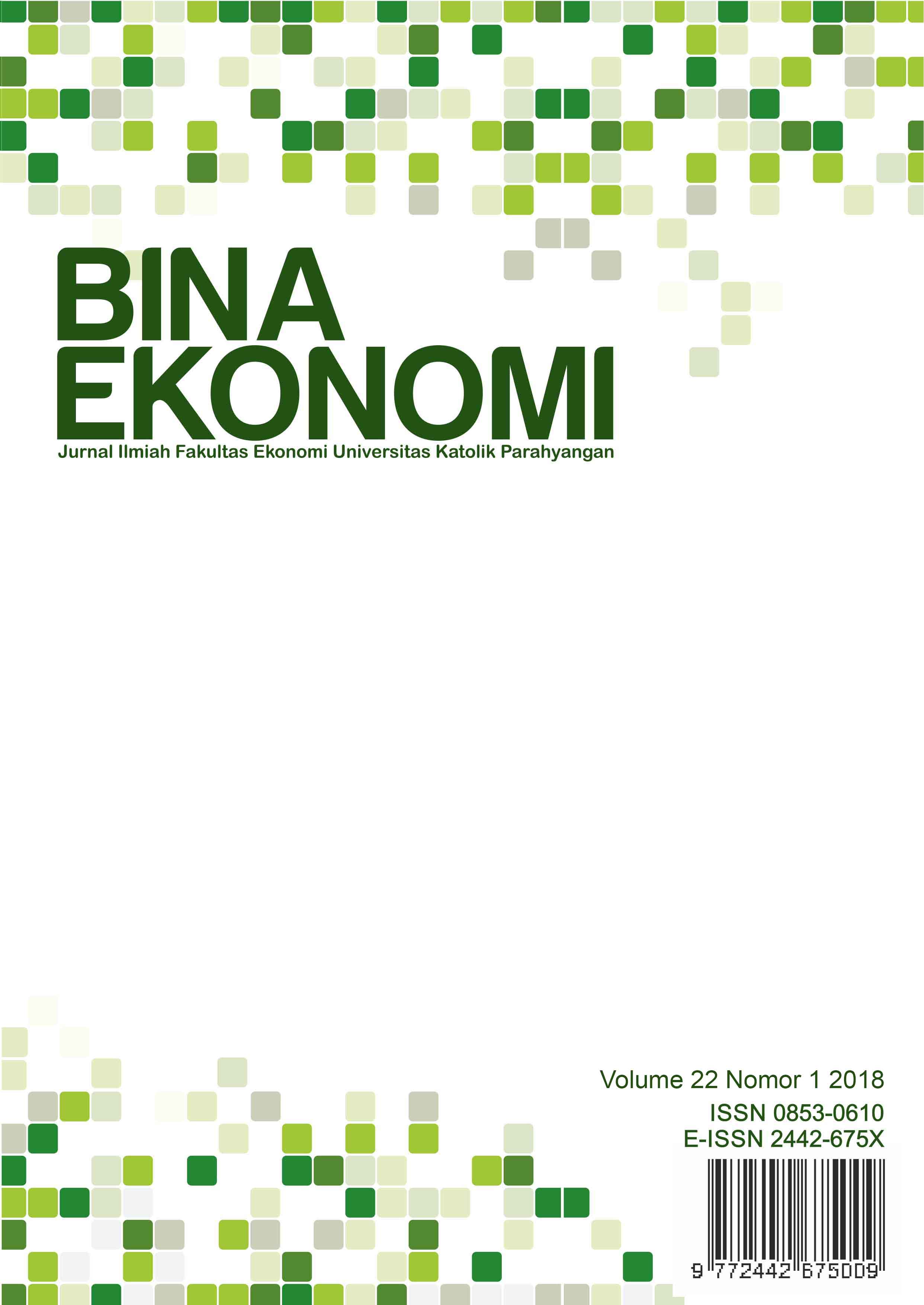ELASTISITAS PERMINTAAN TENAGA KERJA PADA USAHA KONVEKSI SKALA MIKRO DAN KECIL
DOI:
https://doi.org/10.26593/be.v22i1.3727.11-26Abstract
Labor intensive in small and micro scales garment sector is very common in Soreang Village, Bandung Regency, West Java Province. The purpose of this study is to analyze the elasticity of labor demand of the labor-intensive micro-small scale garment enterprises. Sixty seven entrepreneurs were interviewed to collect primary data. Result from natural logarithm regression showed that labor demand was inelastic to the unit number of machines, wage, number of output, and firm age. These regression coefficients showed that unit of machines was complementary for labor; the wage elasticity of labor demand was negative; the increase in production output will lead to increase in labor demand; and, firm age was contributed positively to the increase in labor demand.
Keywords: elasticity of labor demand; small-micro scale enterprises; garment
References
Addison, J. T., Portugasl, P., & Varejão, J. V. (2014). Labour research demand: towards a better aatch between better theory and better data. Diambil dari www.bportugal.pt.
Arrowsmith, J., Gilman, M. W., Edwards, P., & Ram, M. (2003). The Impact of the national minimum wage in small firms. British Journal of Industrial Relations, 41(3), 435–456.
Badan Pusat Statistik Indonesia. (2019a). Jumlah tenaga kerja industri besar dan sedang menurut sub sektor, 2008-2015. Jakarta.
Badan Pusat Statistik Indonesia. (2019b). Jumlah tenaga kerja industri mikro dan kecil menurut 2-digit KBLI, 2010-2015. Jakarta.
Badan Pusat Statistik Kabupaten Bandung. (2017). Kecamatan Soreang dalam angka. Kabupaten Bandung.
Brown, C., & Medoff, J. L. (2003). Firm age and wages. Journal of Labor Economics, 21(3).
Chaudhry, S. A. (2010). Significance of the small and medium enterprises (SMEs) sector in Pakistan and assessment of its employment potential. The Lahore Journal of Economics, 5(1), 23–62.
Chowdhury, M. M. (2015). Small and medium enterprise in Bangladesh-prospects and challenges. 15(7).
Coad, A., Rubæk, J., Krafft, J., & Quatraro, F. (2015). Firm age and performance. (December). doi:10.1007/s00191-017-0532-6.
Darusman, F. M., & Rostiana, E. (2015). Penyerapan tenaga kerja pada sentra industri rajutan Binong Jati Kota Bandung. Trikonomika, 14(1), 25–37.
Dinas Perindustrian dan Perdagangan Kabupaten Bandung. (2015). Jumlah unit usaha dan tenaga kerja industri kecil menengah menurut Kabupaten di Provinsi Jawa Barat. Kabupaten Bandung.
Dung, P. K. (2017). The effects of minimum wage hikes on employment and wages in Viet Nam ’ s micro , small , and medium enterprises (No. 95).
Fatimah, Y. A., Magelang, U. M., Biswas, W. K., Mazhar, I., & Islam, N. (2013). Sustainable manufacturing for Indonesian small- and medium-sized enterprises ( SMEs ): the case of remanufactured alternators. Journal of Remanufacturing, 3(6), 1–11. doi:10.1186/2210-4690-3-6.
Furqon, D. F. (2018). Pengaruh modal usaha, lama usaha, dan sikap kewirausahaan terhadap pendapatan pengusaha lanting di Lemah Duwur Kecamatan Kuwasaran, Kabupaten Kebumen. Jurnal Pendidikan Dan Ekonomi, 7(1), 51–59.
Goldar, B., Pradhan, B. K., & Sharma, A. K. (2013). Elasticity of substitution between capital and labour inputs in manufacturing industries of the Indian economy. The Journal of Industrial Statistics, 2(2), 169–194.
Jonkisz-zacny, A. (2016). Growth of fixed assets in the economy vs labour productivity. Studia Ekonomiczne., (276), 95–106.
Kok, J. M. P. de, Fris, P., & Brouwer, P. (2006). On the relationship between firm age and productivity growth. Scientific Analysis of Enterpreneurship and SMEs, (October).
Kongolo, M. (2010). Job creation versus job shedding and the role of SMEs in economic development. African Journal of Business Management Vol., 4(11), 2288–2295.
Kopasker, D., & Görg, H. (2016). Firm size distribution and employment fluctuations: theory and evidence (No. 10371). Bonn.
Lichter, A., Siegloch, S., Lichter, A., Peichl, A., & Siegloch, S. (2014). The own-wage elasticity of labor demand : a meta-regression analysis (No. 7958). Bonn.
Lundvall, K., & Battese, G. E. (2000). Firm size, age and efficiency: evidence from Kenyan manufacturing firms. The Journal of Development Studies, 36(3), 146–163.
OECD Council. (2017). Enchancing the contributions of SMEs in a global and digitalised economy. Meeting of the OECD Council at Ministerial Level. Paris.
Pemerintah Provinsi Jawa Barat. (2012). Hampir 80% warga Panyirapan Soreang, berusaha konveksi. In Berita Website Resmi Pemerintah Provinsi Jawa Barat. Diambil dari http://www.jabarprov.go.id/index.php/news/3898/Hampir_80_Warga_Panyirapan_Soreang_Berusaha_Konveksi
Pervan, M., Pervan, I., & Ćurak, M. (2017). The influence of age on firm performance: evidence from the Croatian food industry. 2017. doi:10.5171/2017.
Punyasavatsut, C. (2008). Chapter 10 SMEs in the Thai manufacturing industry: linking with MNES. (March), 287–321.
Sulaiman, N., Ismail, R., & Saukani, N. (2016). Labour demand elasticity and manpower requirements of skilled labour in Malaysian manufacturing sector. International Journal of Economic Research, 13(5), 2235–2250.
Tadesse, B. (2010). The role of micro and small enterprises in employment creation and income generation: a survey study of Mekelle city. Mekelle University College of Business and Economics.
Vandenberg, P. (2006). Poverty reduction through small enterprises: emerging consensus, unresolved issues and ILO activities. In Small Enterprise Development.
Woo, C., Chung, Y., Chun, D., & Seo, H. (2014). Exploring the impact of complementary assets on the environmental performance in manufacturing SMEs. Sustainability, 6(10), 7412–7432.


